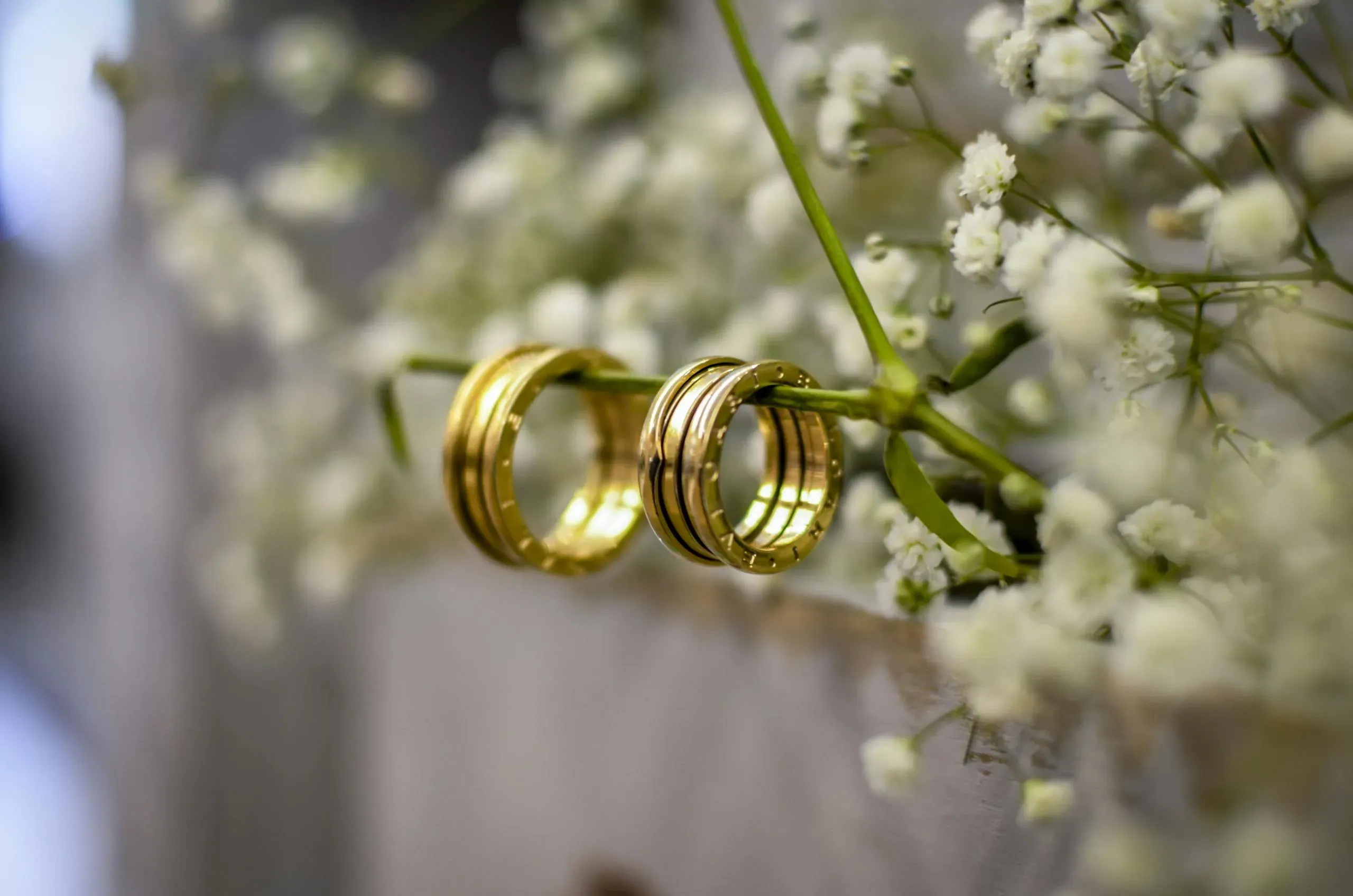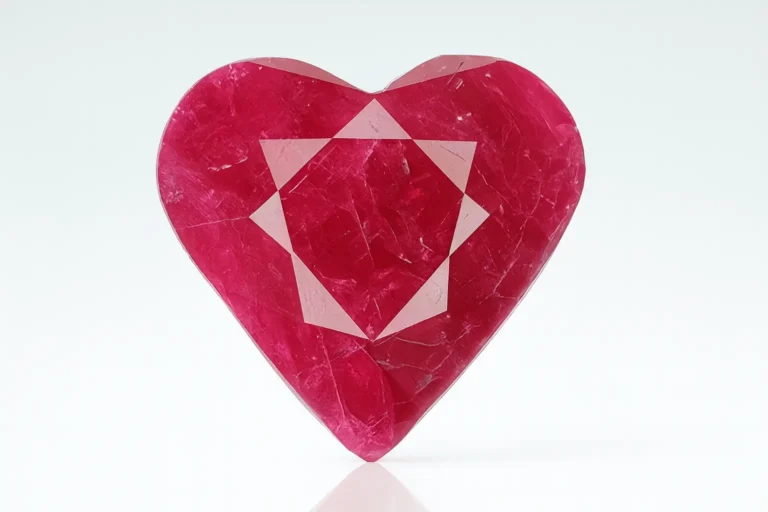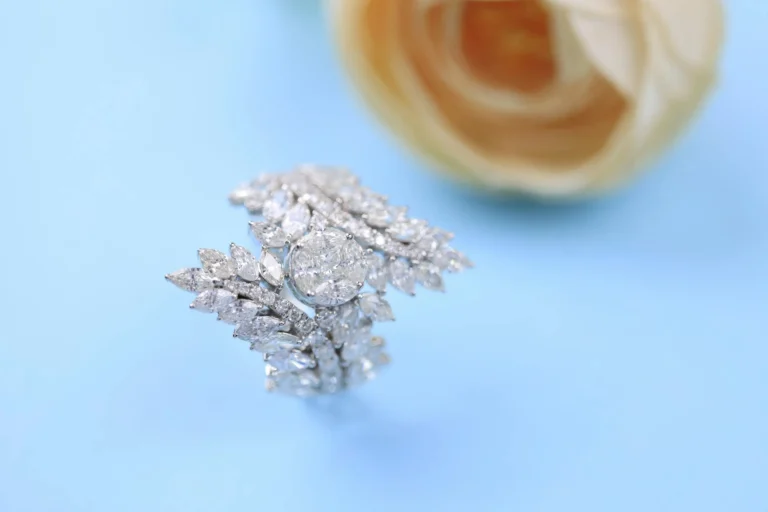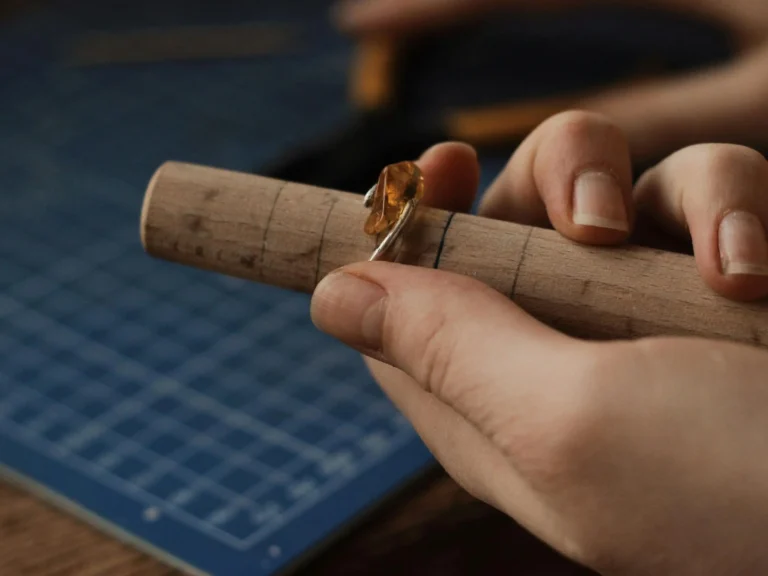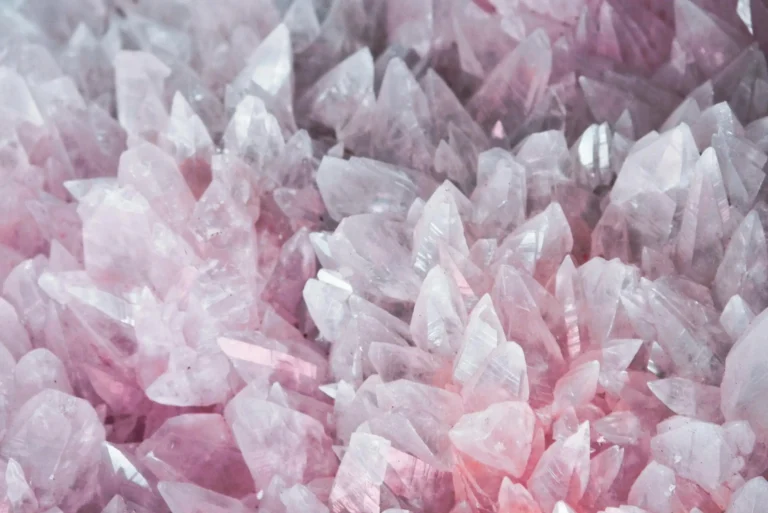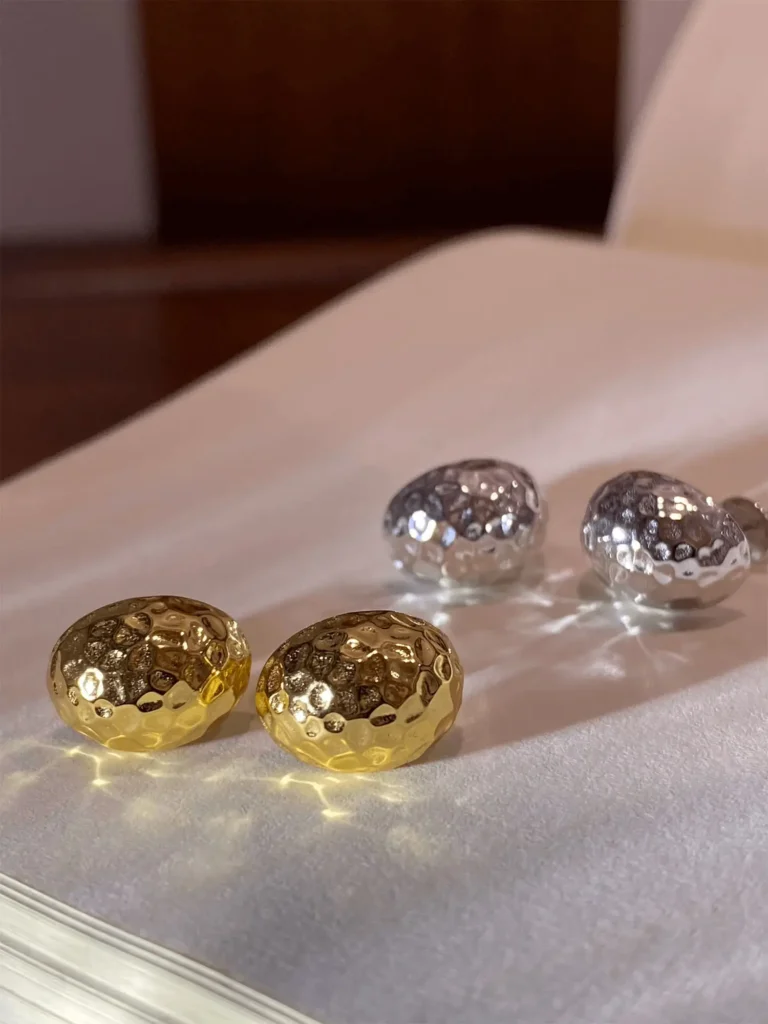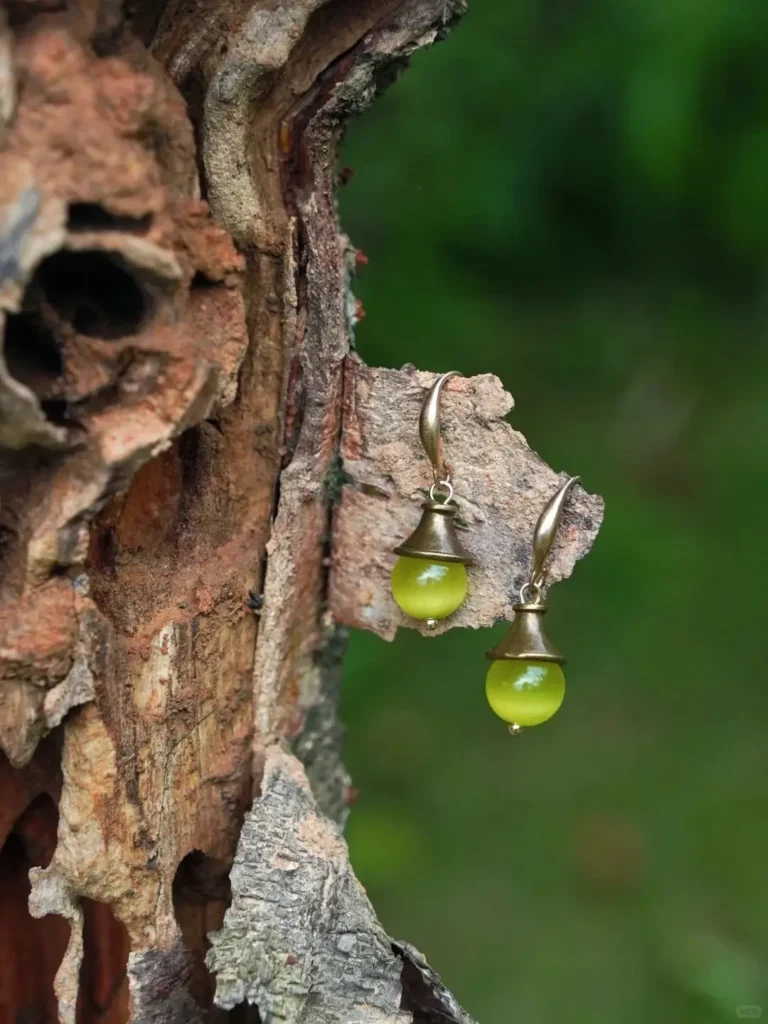The Timelines of Antique Jewelry: A Journey Through History and Craftsmanship
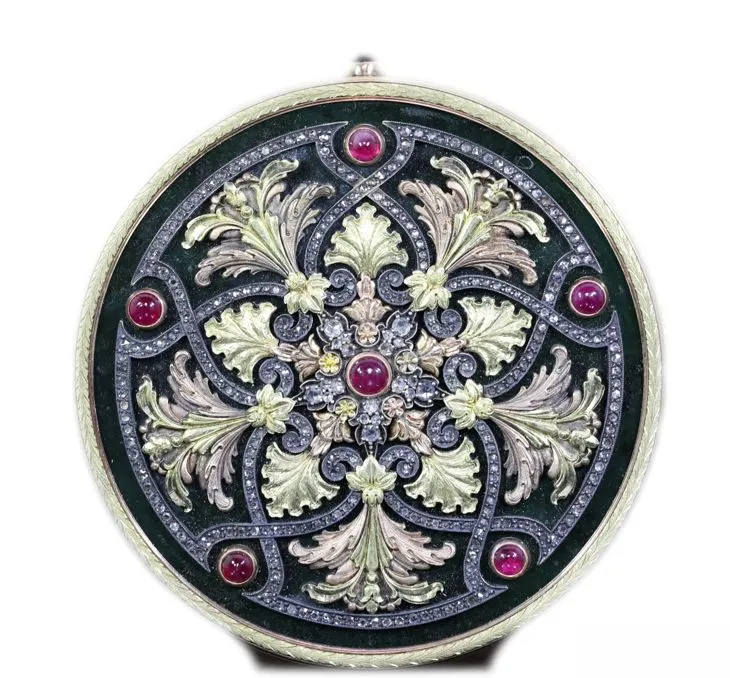
The Soul of Antique Jewelry: A Blend of Beauty, Craftsmanship, and History
Antique jewelry carries more than just beauty—it holds history, craftsmanship, and cultural meaning. I’ve said it before:
The value of jewelry ≠ the price of jewelry.
Jewelry’s value isn’t just about the price tag. It’s a combination of the price, the craftsmanship, the culture, the history, and the ideas behind it.
Only when these elements come together does antique jewelry truly have a soul. European antique jewelry, as a blend of artistic craftsmanship, cultural significance, and rich history, is gaining more and more recognition. People are drawn to its beauty, its story, and the intricate craftsmanship behind it. You might not be able to put it into words just yet, but today, let’s dive into the story behind European antique jewelry.
What Defines Antique Jewelry? Definition and Time Frame
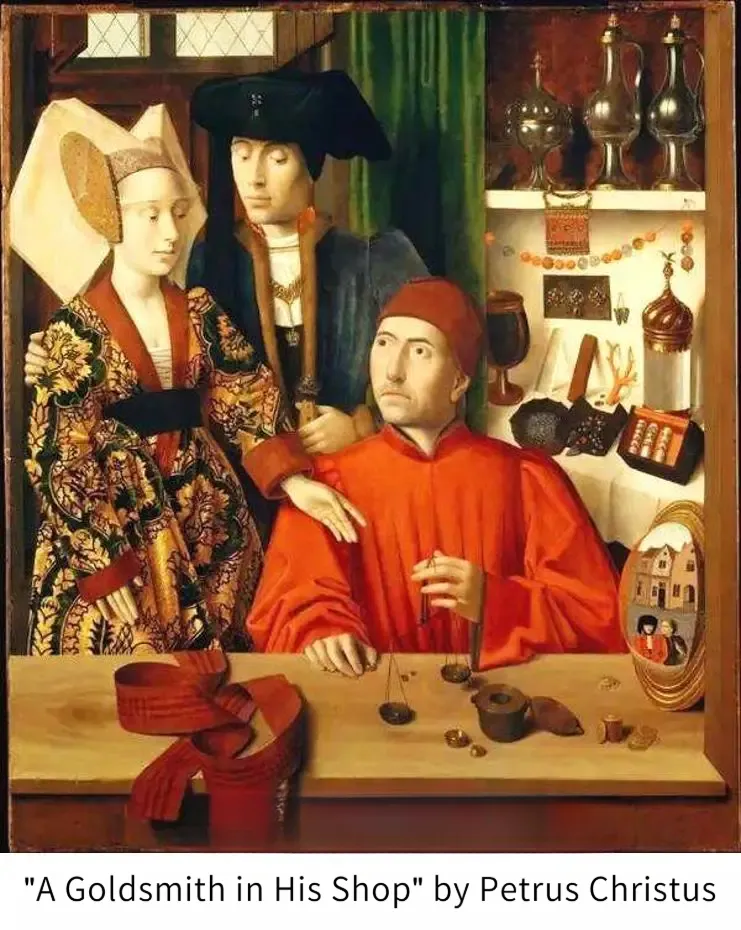
Let’s take a look at this oil painting titled A Goldsmith in His Shop, painted in 1449. The goldsmith, with a proud look in his eyes, is the central figure. A young couple dressed in luxurious clothing seems to be shopping for jewelry in his shop. Behind the goldsmith, there are different rings and brooches displayed. This painting is over 500 years old. Some might ask, “Is this antique jewelry?” Of course, it is. But then, someone may wonder, what qualifies as antique jewelry?
Some say antique jewelry reflects the history of human civilization, and that’s not untrue. Jewelry, from the very beginning, was tied to religious beliefs. Later, it became a symbol of status. Today, people treat jewelry as a daily essential, much like clothing. Clearly, jewelry has been around since ancient times. However, we now define antique jewelry as anything from before the 1960s. Anything made before that is considered antique jewelry.
Five Key Periods of European Antique Jewelry
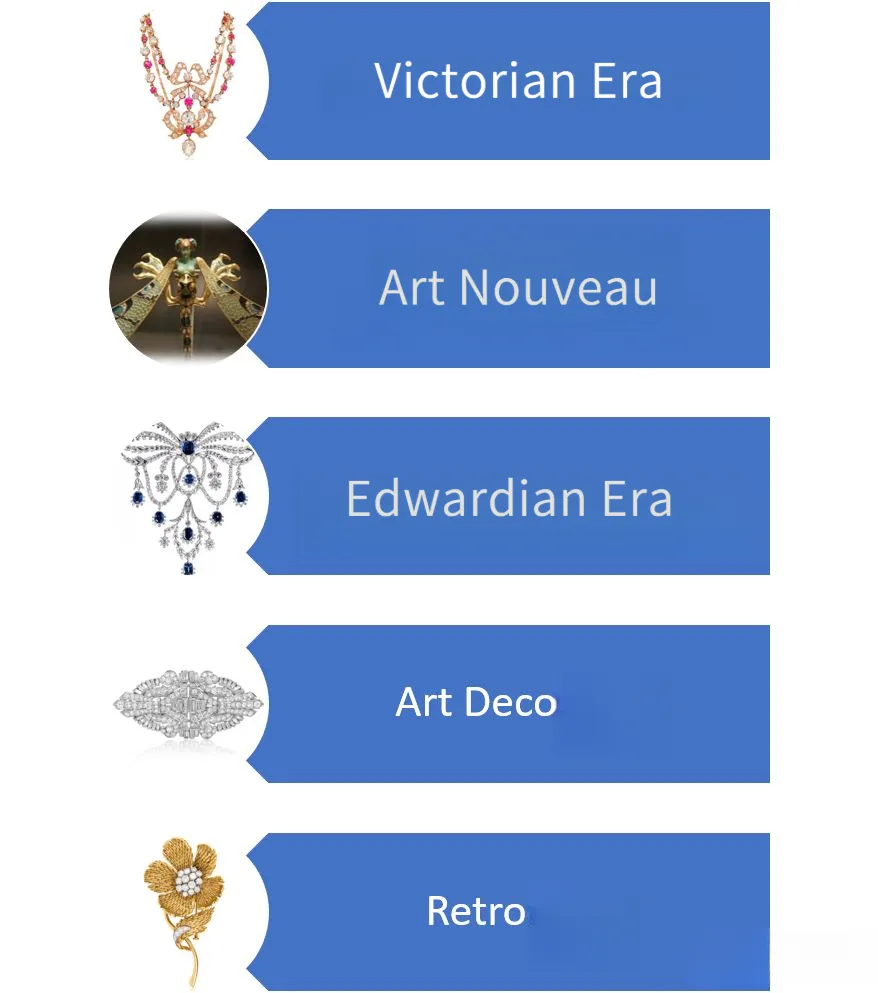
However, ancient jewelry isn’t suitable for modern wear. It has either ended up in museums or research institutions, and we can only experience their existence through frescoes or oil paintings. The antique jewelry we typically refer to ranges from the 1830s to the 1960s. Based on their styles, later generations have further categorized them into five key periods:
I. Victorian Era Antique Jewelry (1837–1901)
The first significant period to examine is the Victorian Era. Before the Victorian period, there was the Georgian Era, but jewelry from that time is rare for several reasons:
- It wasn’t until the 1840s that gold was discovered in the United States.
- In the 1870s, large diamond mines were discovered in South Africa.
You’ll notice that jewelry from the 18th century or early 19th century is quite scarce. A major reason for this is the shortage of materials, where metals had to be melted down and reused, and gemstones needed to be reset. Today, we can only admire the charm of those antique jewels through oil paintings.
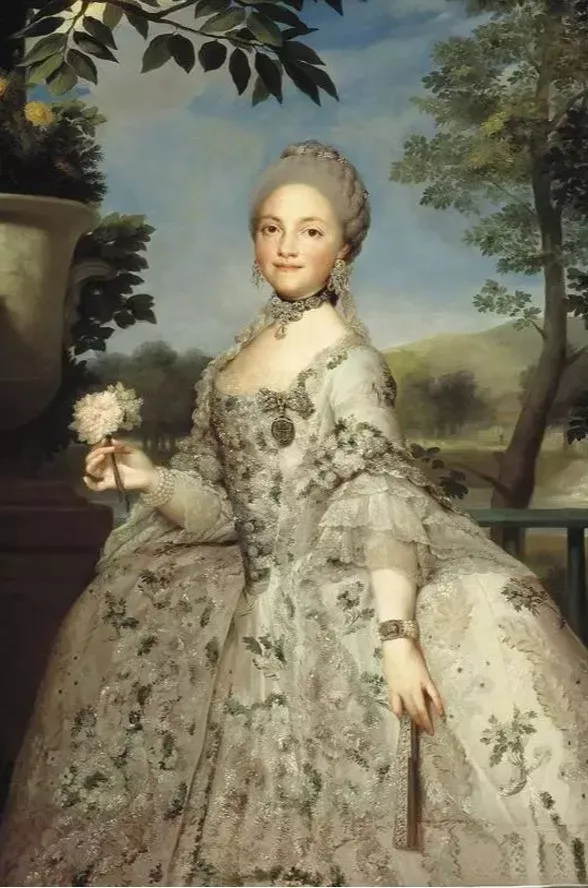
Anton Raphael Mengs
Maria, as she appeared in 1765, shortly after marrying Charles IV.
Alright, let’s return to the Victorian era. Queen Victoria reigned for 64 years, and the Victorian era is typically defined as from 1837, when the Queen ascended the throne, to the early 20th century. The reason we don’t give a precise end date is that, although the Queen passed away in 1901, the style of the Victorian period continued to influence design for years afterward.
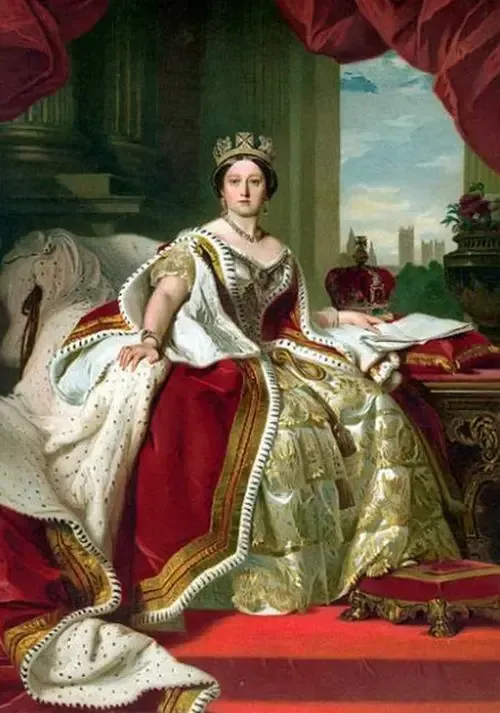
Queen Victoria, with her legendary life, played a pivotal role in shaping the British Empire into its most prosperous period, often referred to as the “Empire on which the sun never sets.” Alongside her husband, Prince Albert, she made immense contributions not only in politics but also in the world of jewelry. Additionally, the globally renowned British afternoon tea tradition also emerged during their era.
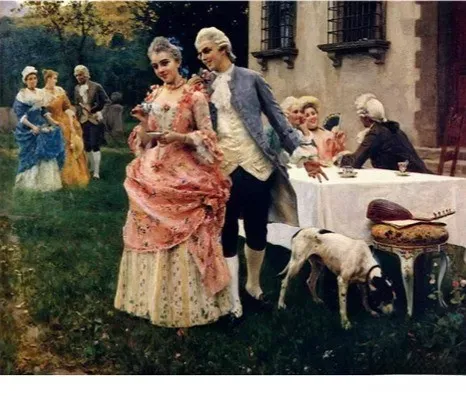
Throughout the Victorian era, with the constant changes in politics, major events, and fashion trends, we also saw several transformations in jewelry design. Due to the long span of time, we further divide the Victorian era into the early, middle, and late periods.
1. Early Period: The Romantic Period (1837–1860)
In her youth, Queen Victoria dressed modestly and prudently, preferring to wear beautiful yet inexpensive jewelry. She had a fondness for flowers and bows, which were typical motifs in British Romantic period jewelry. At the age of 18, Queen Victoria began to rule on her own.
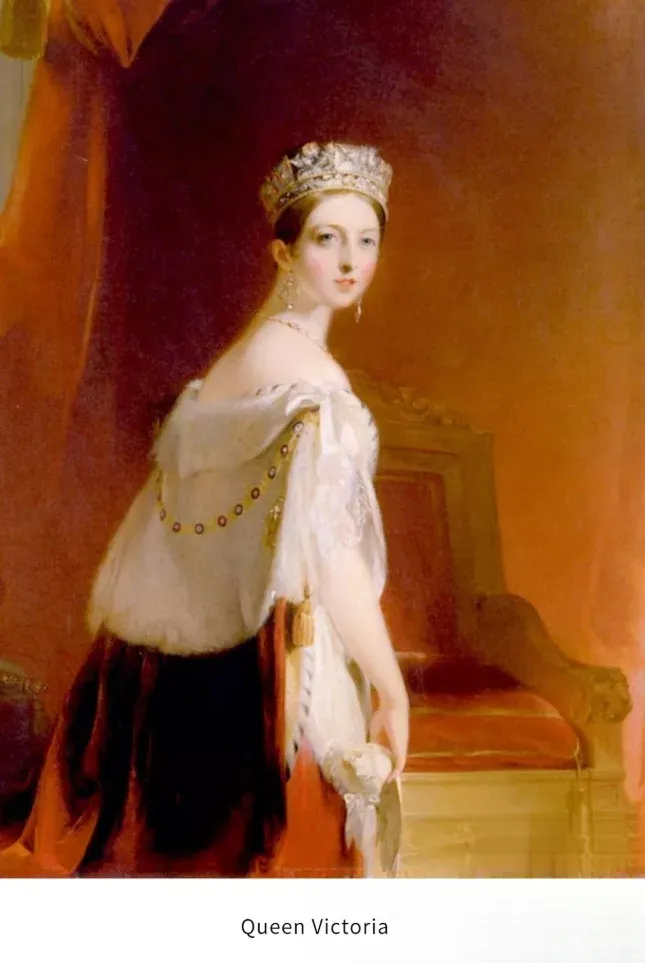
In the image, Queen Victoria is wearing the diamond necklace gifted to her by King George IV, while the diamond dangle earrings were a gift from Queen Charlotte. The dangle earrings were also typical of early Victorian jewelry. This is why royal jewelry is often regarded as the best representation of heritage and legacy.
Three years later, the young queen married, and Prince Albert gave her the perfect marriage that would bring her lifelong happiness. During this period, the entire society was filled with an atmosphere of happiness, sweetness, and romance.
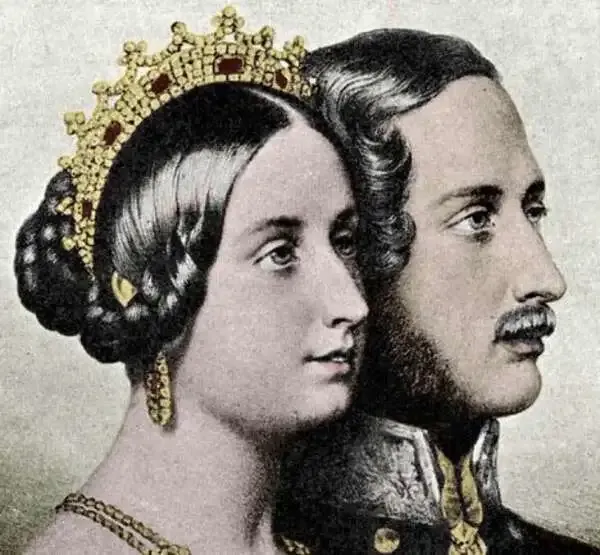
The Softness of Romance: Delicate Plant Motifs
In this era of rosy romanticism and peace, plant patterns were all the rage. Ivy, scrolls, branches, berries, grapevine, and lotus motifs all transformed into dazzling jewelry pieces.
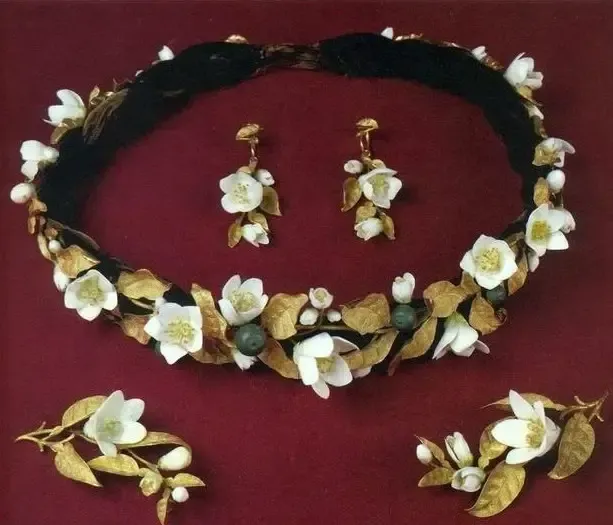
A Dominant Trend: The Two Decades of Coral Supremacy
From 1845 to 1865, coral appeared in various forms, including coral cameos. Of course, it wasn’t just coral cameos, but also materials like amethyst, agate, and others. Queen Victoria’s personal love for cameos played a major role in the popularity of “Romantic Period” cameo jewelry, which swept through high society under her influence.
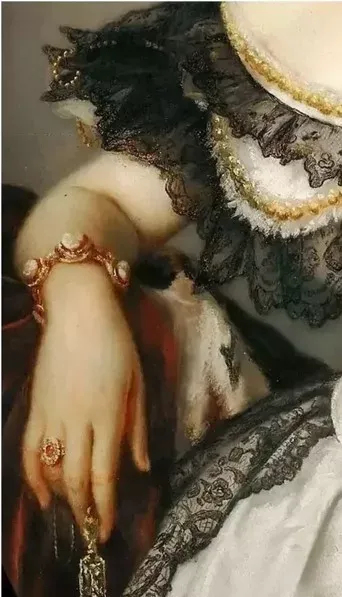
Eternal Love: The Symbolism of Serpent Jewelry
This painting by artist David Wilkie depicts Queen Victoria’s first parliament session after her ascension. At that time, the Queen wore a serpent-shaped bracelet. In fact, Queen Victoria had many “ouroboros” (tail-biting snake) jewelry pieces from her youth. However, this particular bracelet was a birthday gift from Queen Adelaide in 1837, symbolizing “serpentine wisdom.” From then on, serpent-shaped jewelry became highly fashionable, reaching its peak in the 1840s.
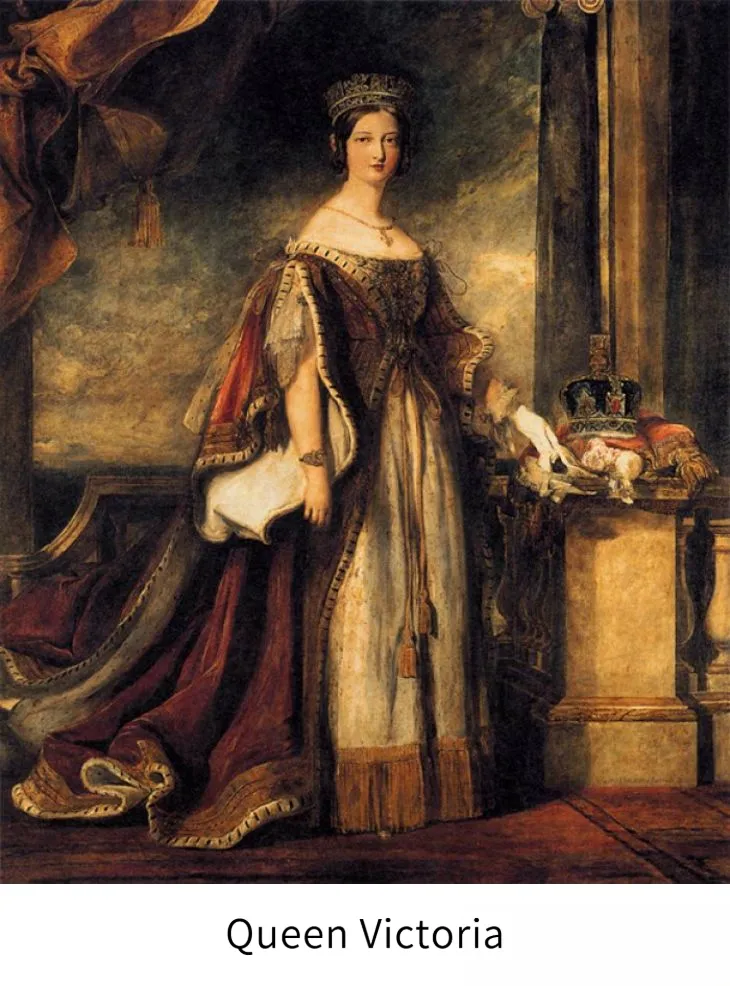
When it comes to serpent jewelry, one cannot overlook their symbol of love. We must mention the engagement ring Prince Albert gave to Queen Victoria in 1840. The ring was designed in the shape of a serpent, symbolizing eternal love, and featured Queen Victoria’s birthstone—a round emerald.
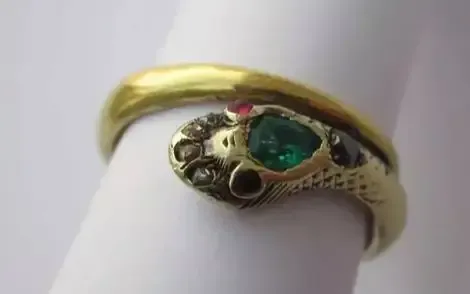
Such a meaningful design not only captured the Queen’s heart but also set a new trend in British society’s jewelry fashion. Women of the Victorian era typically wore serpent-themed jewelry, such as bracelets and brooches, in various daily settings. Moreover, the romantic gesture of gifting an engagement ring became a tradition that has been passed down through generations.
Defining Tradition and Fashion: Queen Victoria’s Iconic Wedding
Their love story goes far beyond this. In 1840, Queen Victoria’s wedding dress was custom-made to fit her petite frame. At her insistence, all the materials for the dress were sourced from within the UK. It was also Queen Victoria who set the tradition of wearing a white wedding dress, a custom that began with her and has persisted ever since. Before the Victorian era, noblewomen typically wore silver wedding dresses.
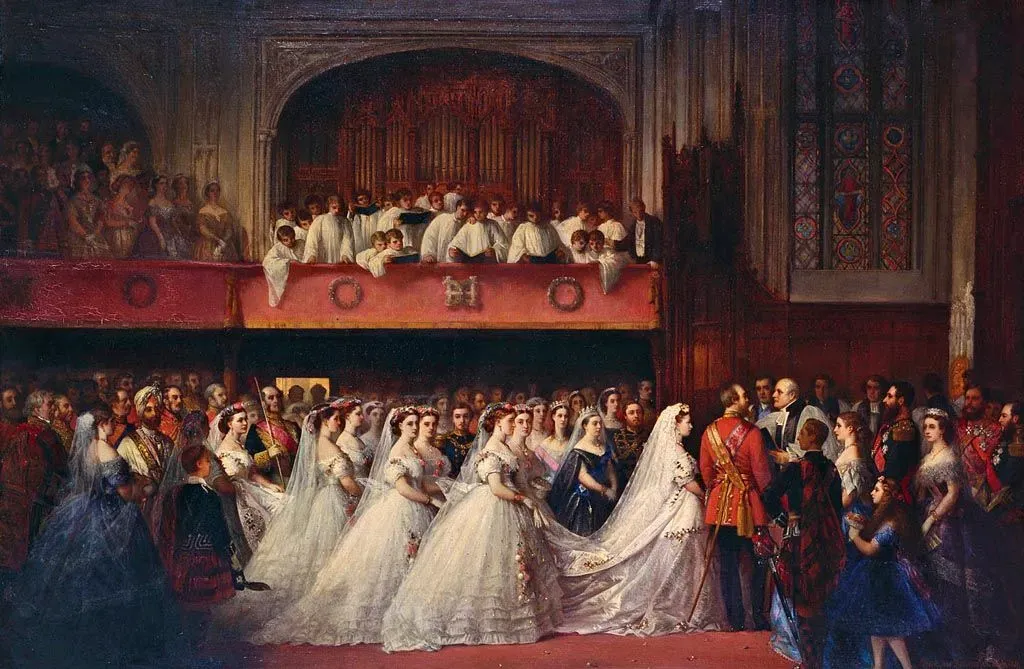
The orange blossom crown Queen Victoria wore at her wedding has its origins in the 12th century Spanish tradition. For many years after, brides who couldn’t afford or find fresh orange blossoms would make crowns from wax, which were then passed down through generations within families.
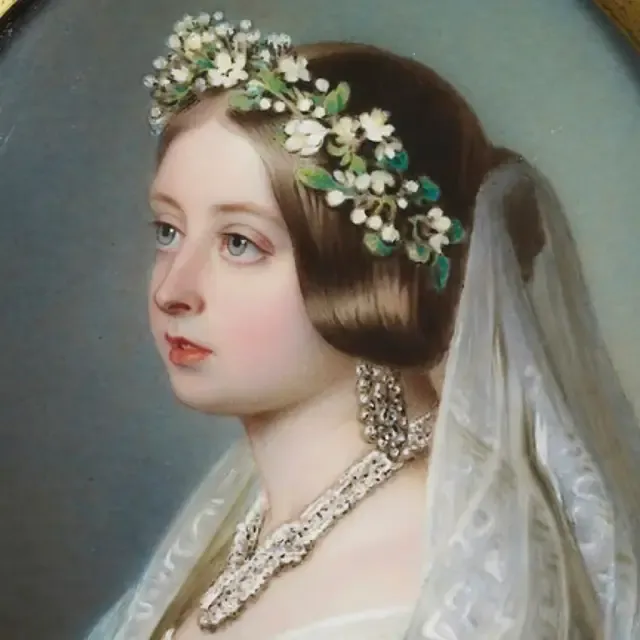
Queen Victoria was a fashion enthusiast in her youth, always chasing the latest trends. However, after ascending to the throne, she became a trendsetter, shaping fashion for an entire era.
2. Mid Period: The Grand Period (1860–1885)
The Grand Period marked the rise of mourning jewelry, stemming from Queen Victoria’s deep sorrow following the deaths of her mother and Prince Albert. As a result, black jewelry made from jet—fossilized wood—became a symbol of grief.
The Carrier of Emotion: The Emergence of Mourning Jewelry
In 1861, Queen Victoria’s mother, the Duchess of Kent, passed away, followed shortly by the death of Prince Albert. The immense sorrow left the Queen almost incapacitated. From that point onward, she wore mourning attire for the rest of her life. The somber atmosphere throughout Britain led to the rise in popularity of black jewelry and hair accessories made from jet, a dark, fossilized wood. This gave birth to what we now call mourning jewelry or sentimental jewelry.

A Shift in Style: The “Eccentric” Fashion Trends
The 1860s and 1870s are often referred to as the “eccentric years.” Women wore skirts that were excessively wide, and tightly laced corsets accentuated their curves. Another notable transformation was the gradual shift in fashion where women, once hiding their ears beneath their hair, began to expose them. This shift led to a sudden surge in the demand for earrings and ear accessories.
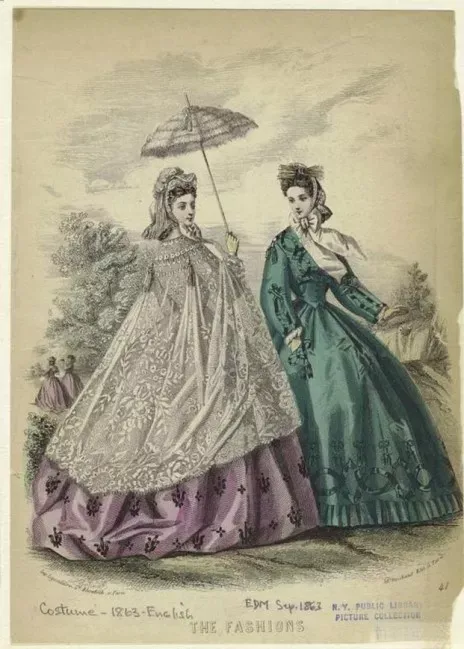
Echoes of History: The Wave of Archaeological Revival Jewelry
At the same time, a wave of archaeological revival swept through society, leading to the emergence of a large number of vintage-inspired jewelry pieces.
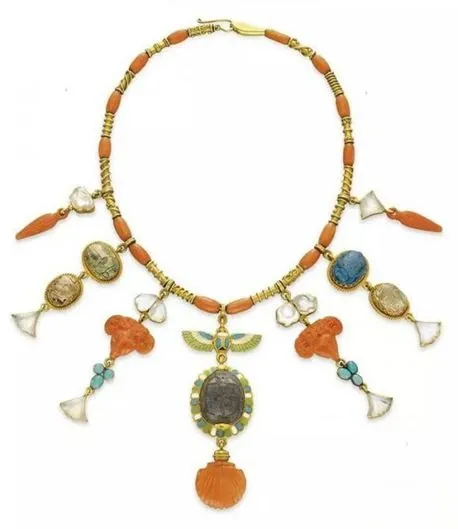
Symbol of the Empire: Exaggerated Statement Bangles
During the mid-Victorian period, antique bangles became a dominant fashion statement. Britain entered a time of prosperity during this era. Skilled artisans crafted large, bold bracelets, drawing inspiration from various civilizations. These extravagant pieces symbolized the strength and wealth of the empire, featuring treasures from across the globe.
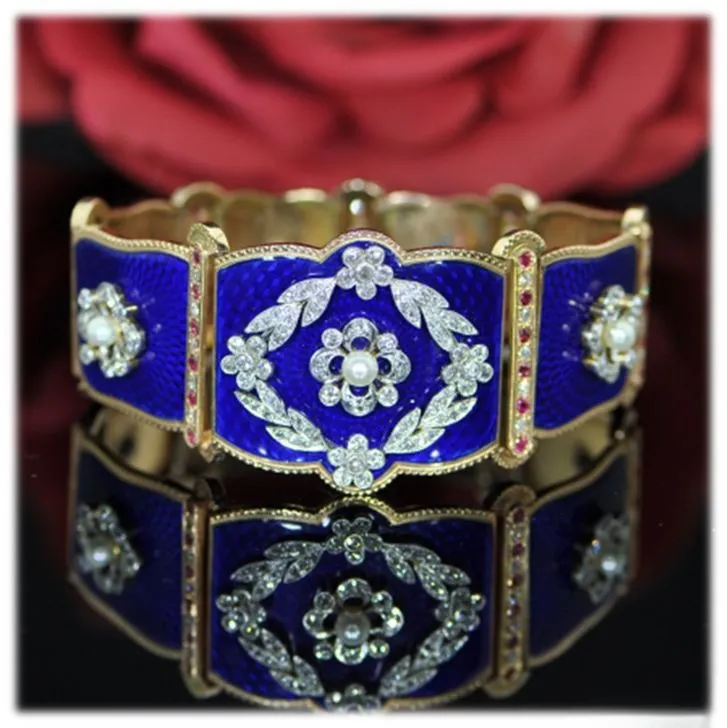
The South African Diamond Rush: Solidifying the Gemstone’s Status
In the 1870s, colorless gemstones became a trend, with diamonds emerging as the leading gem. Over the next 20 years, its position was solidified. This shift was due to the discovery of diamond mines in South Africa in 1867, which increased production and lowered prices.
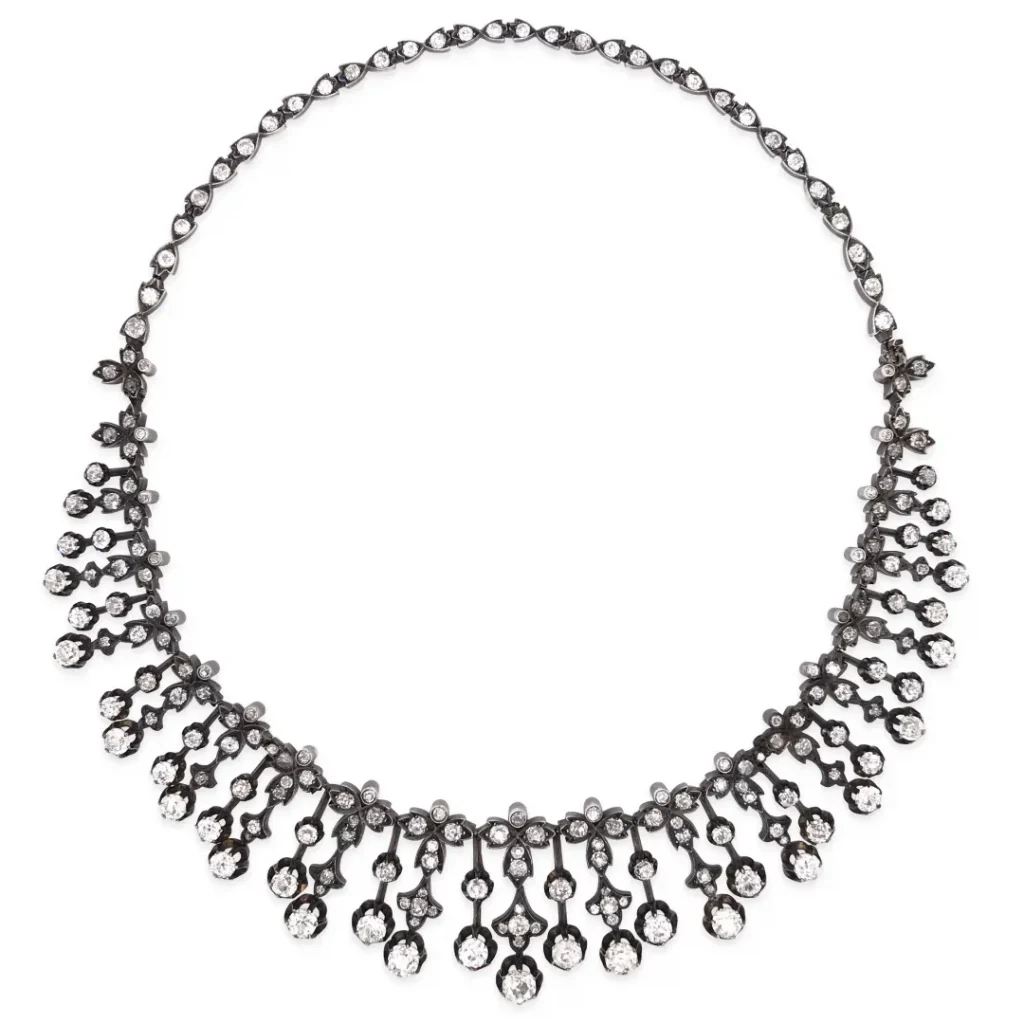
Moving Towards Mechanization: The Rise of Industrial Production
In the 1860s, jewelry workshops began widely using internal combustion engines and steam engines, marking the beginning of mechanized production. Meanwhile, in Amsterdam, machines were already being used to cut diamonds and gemstones.
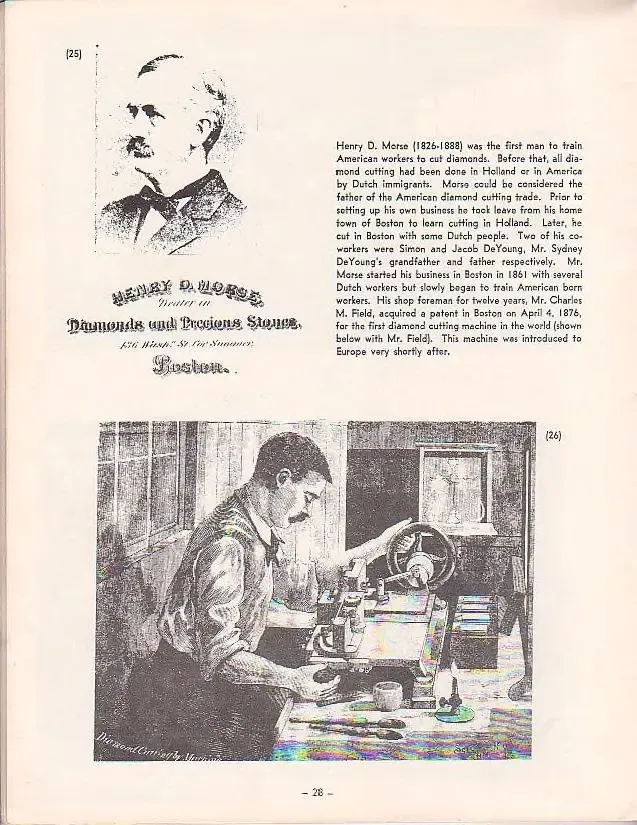
3. Late Period: The Aesthetic Period (1885–1901)
This period saw smaller, more refined pieces of jewelry. Women’s tastes evolved, and they sought delicate designs that emphasized beauty and elegance rather than just gemstones and precious metals.
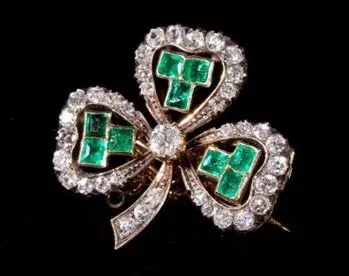
A New Generation’s Icon: Queen Alexandra’s Aesthetic Influence
During the later years of the Aesthetic Period, the jewelry association became concerned that women were almost ready to abandon jewelry altogether. In a hurry, they invited the Princess of Wales to choose jewelry as a way to set an example. Who was the Princess of Wales? She was later Queen Alexandra, the wife of King Edward VII. She successfully took over Queen Victoria’s role as the fashion icon of her time, becoming the new leader of fashion for the next generation.
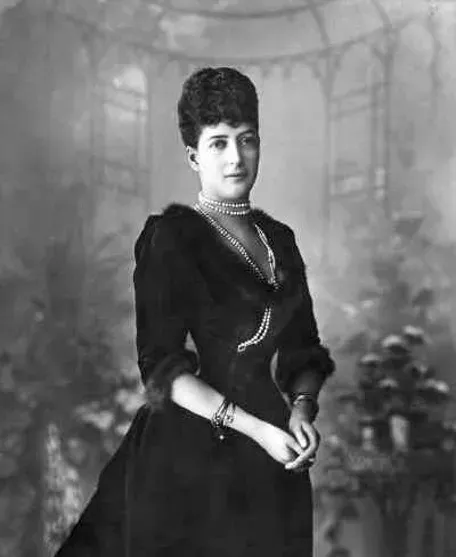
II. Art Nouveau Period Antique Jewelry (1895–1910)
The Art Nouveau period was a groundbreaking aesthetic revolution, opposing the intricate designs of the Victorian era. Designers emphasized nature-inspired motifs and handcrafted work, rejecting mass production and focusing on organic forms.
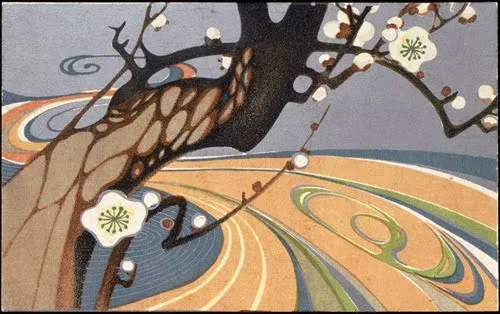
It appears in every book on antique jewelry—sometimes even as the sole subject of an entire volume. It has influenced generations of jewelry designers. Some say that without it, the history of jewelry would be missing its soul.
Core Features and Innovative Materials of Art Nouveau Jewelry
Chronologically, we should have moved on to the Edwardian era by now.Art Nouveau overlaps with both the late Victorian period and the Edwardian era—and it profoundly shaped both. That’s why I’m letting it jump the line.
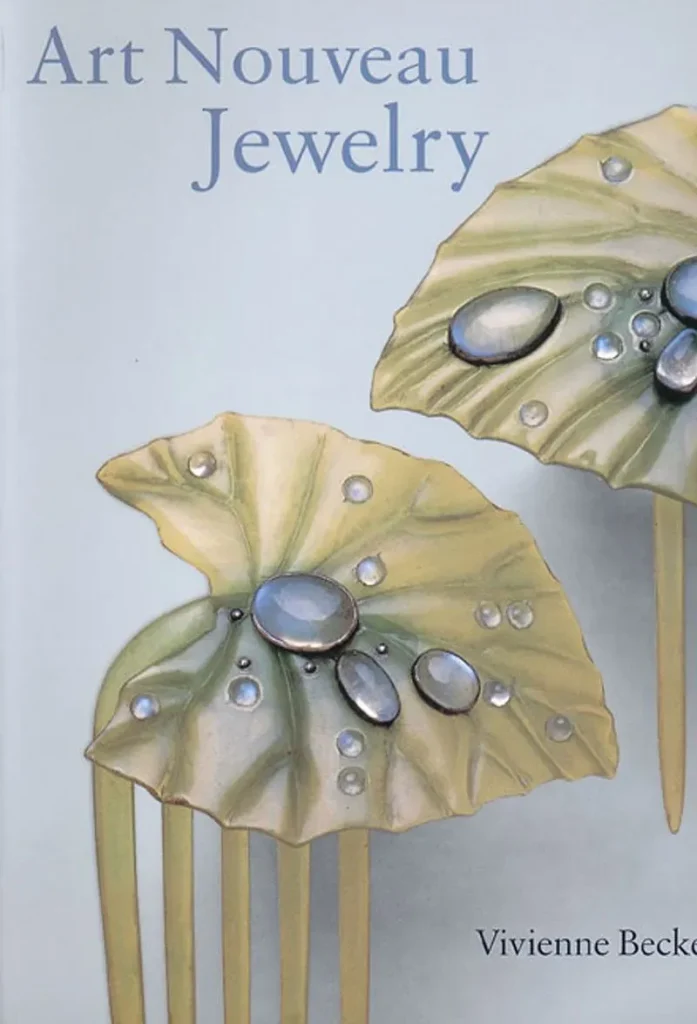
Jewelers began replacing most colored gemstones with enamel during this period. They often used diamonds to decorate borders or create elegant lines. The most common materials also included pearls, opals, moonstones, chrysoprase, agate, and more. With these stones, designers let their imaginations run wild, creating designs filled with dreamlike colors.
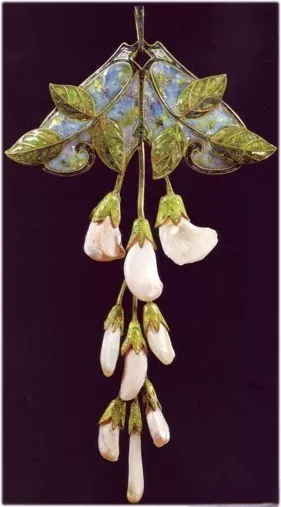
From the jewelry of the Art Nouveau period, we can see the main themes that designers embraced:
A love for nature + emphasizing feminine features.
They replaced the usual hard metals and gemstones with soft, fluid organic materials. This created magical imagery and unmatched beauty, capturing the flowers, plants, fish, and insects of nature, as well as the fairies and spirits of dreams, in stunning detail.
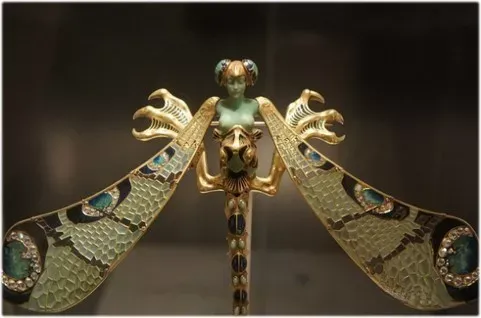
An important technique we must mention from this period is enamel.
Among them, translucent enamel stands out as a classic technique of the time and one of the most difficult to master. Jewelers made enamel the most important material in jewelry during the Art Nouveau movement—and that’s no exaggeration.
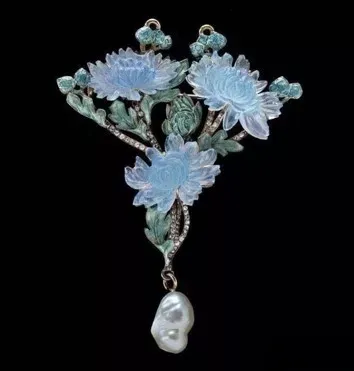
Merville once said, “The metals feel alive, as if the artist breathed life into them.” They appear as soft as skin, almost as if they are magically sweating.”
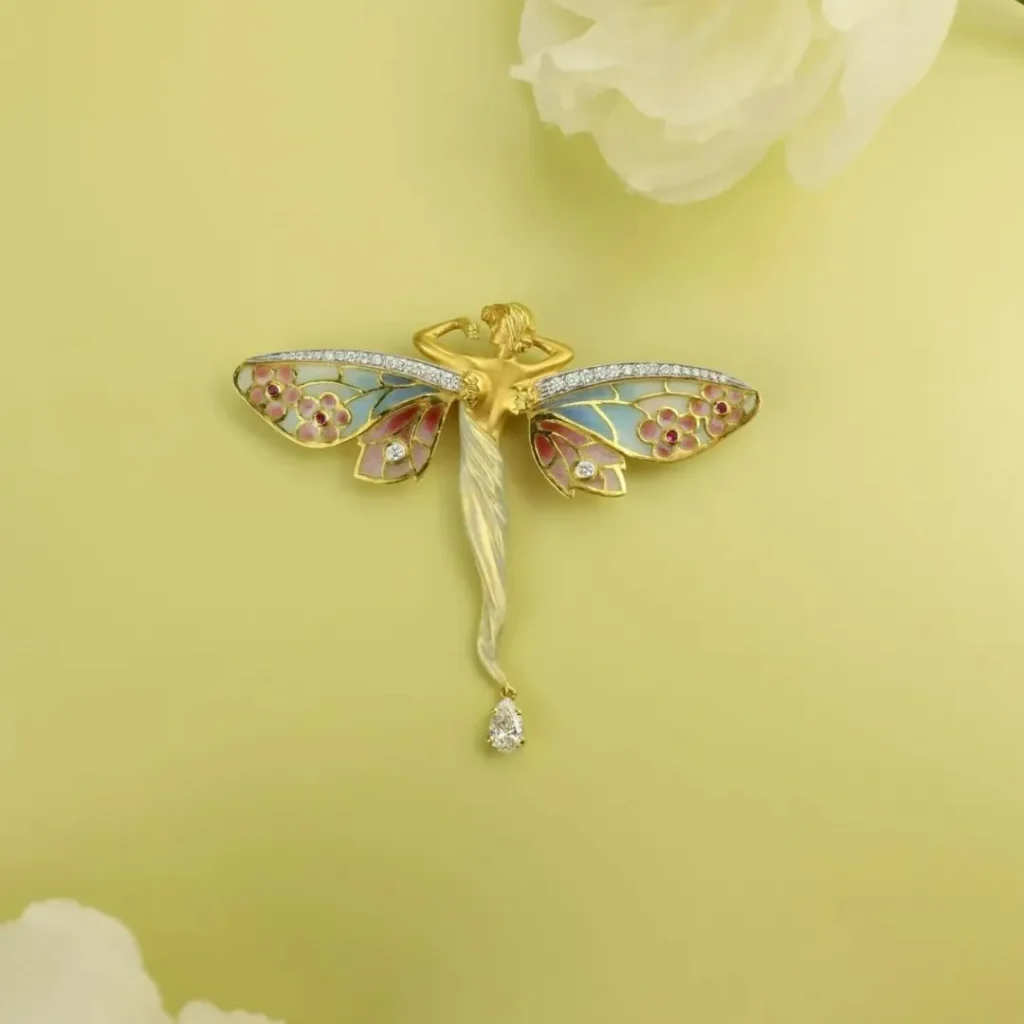
III. Edwardian Era (1901–Around 1915)
Though the Art Nouveau period was once brilliant, its popularity didn’t last long. Once the trend faded, the aristocracy returned to a preference for precious gemstones in their jewelry fashion.
Let’s move on to the Edwardian era (early 20th century – around 1915). After Queen Victoria passed away in January 1901, her son, Edward VII, ascended the throne. By the time he became king, he was already 59 years old. His reputation? Luxury and charm.
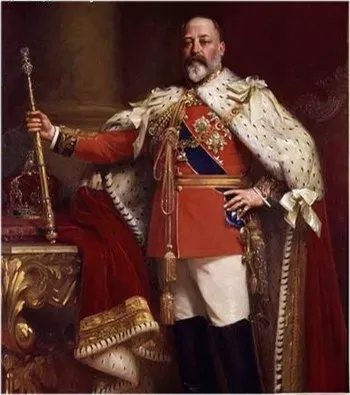
Designers still drew inspiration from Victorian styles during this period, but they gave the jewelry a brighter, more refined touch. It combined elements of the Louis XVI style, such as streamlined designs, and featured swirling floral patterns, garlands, ribbon-like bows, and heart shapes, which made a comeback as popular motifs. One of the most distinctive features of this time was the floral wreath crown.
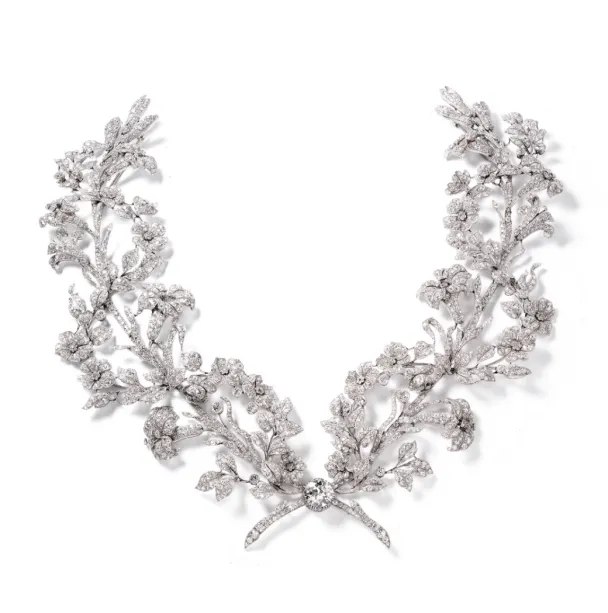
The Royal Darling: Cartier’s Influence with the “Garland Style”
Louis-François Cartier earned his reputation as the master of garland-style designs. He encouraged his designers to draw inspiration from 18th-century styles, and elements like garlands, crowns, bows, and tassels became some of his favorite decorative motifs.
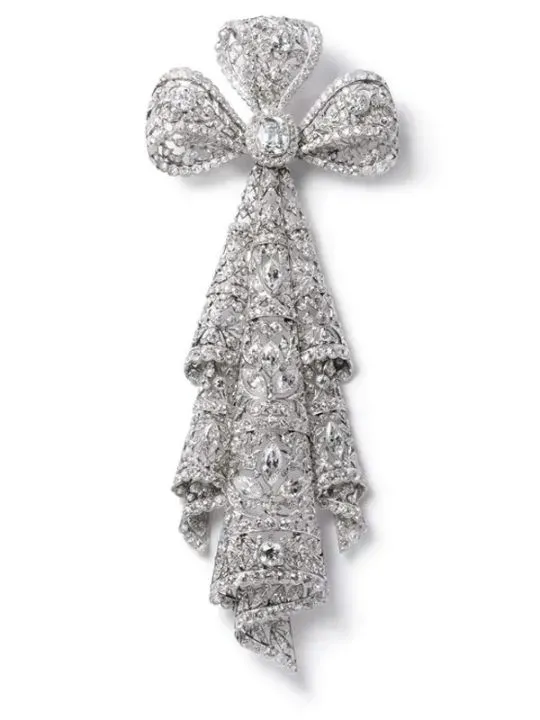
Cartier’s designs captivated everyone-from royal aristocrats to high-society celebrities. Cartier opened stores in London in 1902 and in New York in 1909. By that time, Cartier’s garland-style jewelry had already become a global sensation.
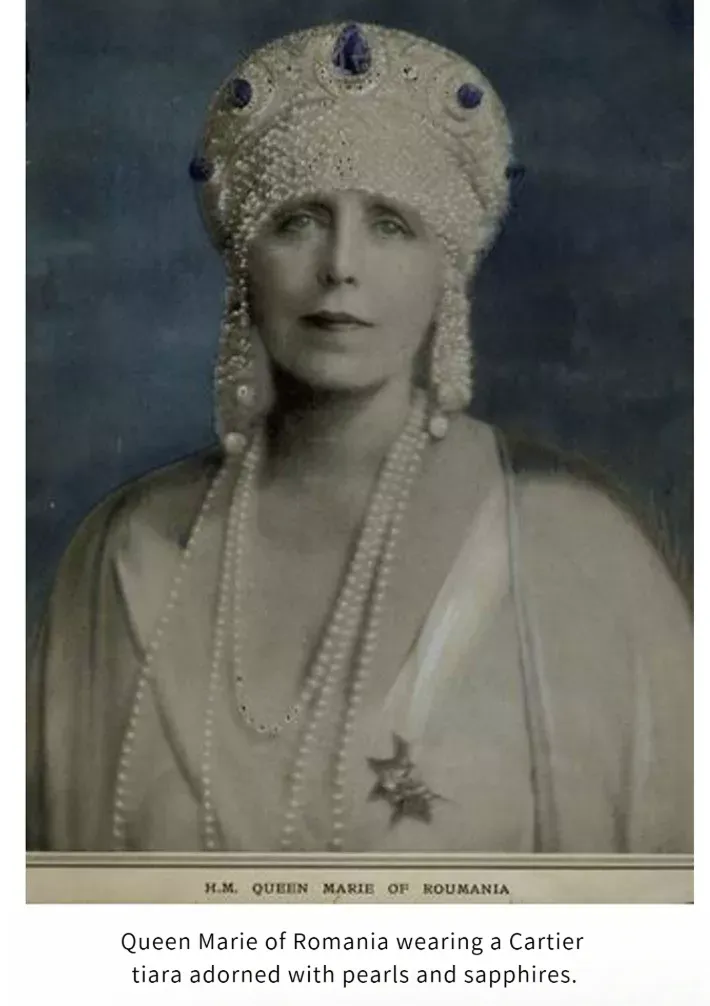
Edward VII had a deep love for jewelry, especially for crowns. He ordered 27 crowns from Cartier, boosting the brand’s reputation across European royal courts.
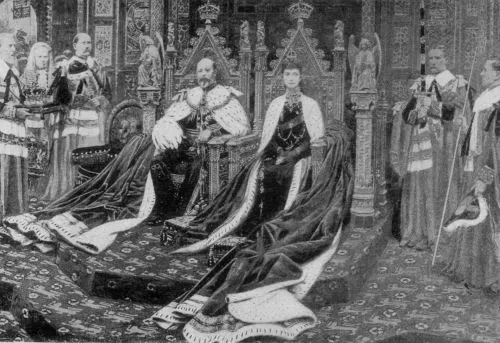
In 1901, Queen Alexandra ordered an Indian-style necklace from Cartier to complement three dresses gifted to her by the wife of the Viceroy of India. In 1904, the British royal family granted Cartier its first royal warrant, and Edward VII appointed the brand as “Jeweller to the Emperor.”
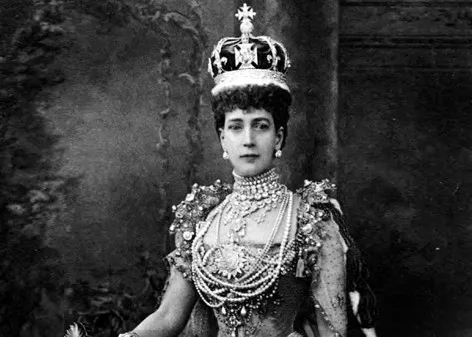
Edward VII and his wife, Queen Alexandra, were some of Cartier’s most loyal and prestigious clients. Clients ordered everything from small veil pins to grand gifts for foreign dignitaries from Cartier. As the royal jeweler, Cartier crafted pieces for every major celebration and important event.
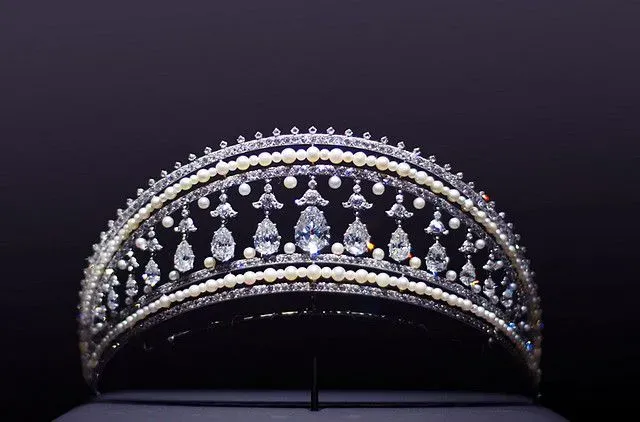
Neckline Elegance: Queen Alexandra and the Choker Trend
We’ve previously mentioned Alexandra, the Princess of Wales, who became a fashion icon after Queen Victoria. She made high-neck dresses popular again, believing they highlighted her long neck. Alexandra adored choker-style necklaces, often wearing layered, winding designs that beautifully wrapped around her neck.
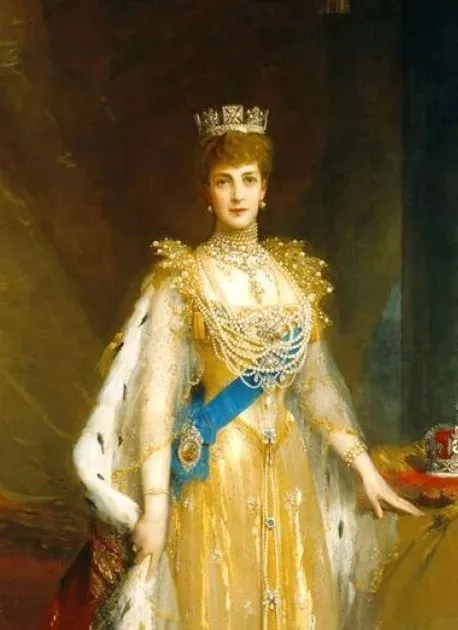
The queen’s necklace caused a worldwide frenzy once she wore it. Choker-style necklaces, made of diamonds, large pearls, tiny seed pearls, and coral beads, adorned the delicate necks of women everywhere.
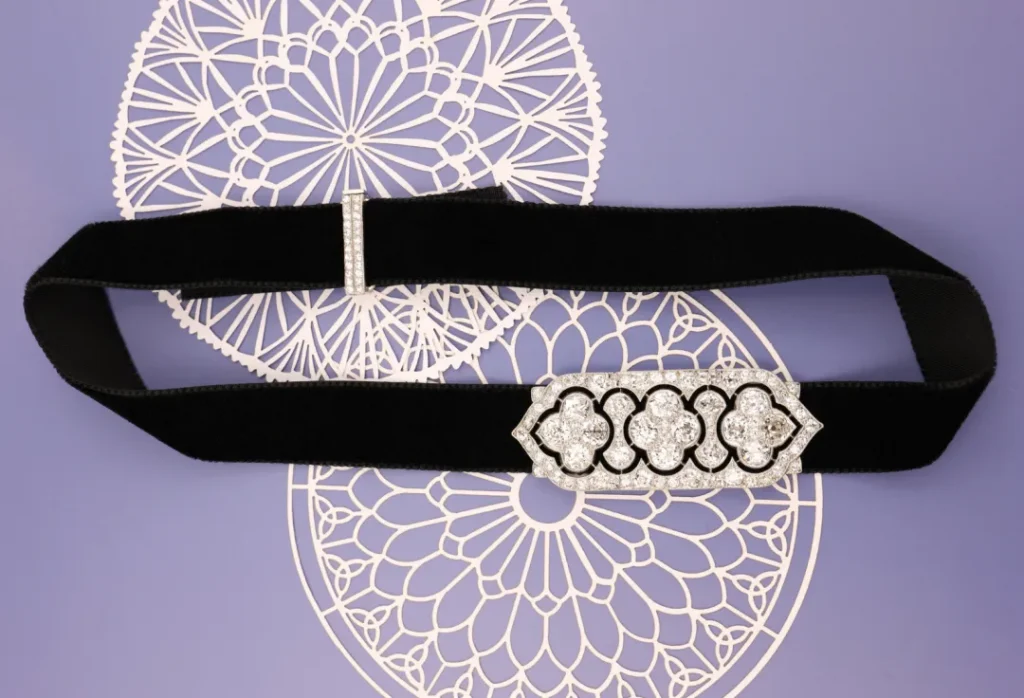
Soft lines, lace detailing, and diamonds of various sizes – creating these beautiful garland-style pieces required a light, refined touch. Gold and silver simply couldn’t meet the demands of such delicate designs. In 1903, the invention of the oxy-acetylene torch allowed for the widespread use of platinum, a material perfect for these intricate creations.
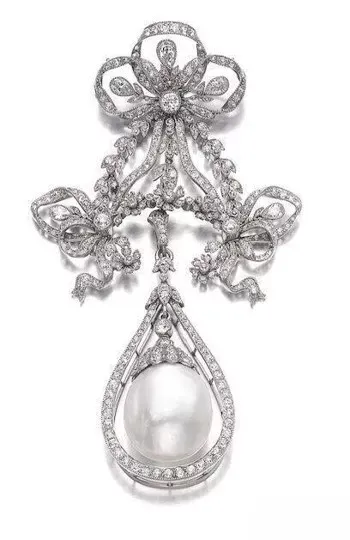
The hardness and durability of platinum allowed jewelers to minimize the amount of metal used, highlighting the diamonds and enhancing their brilliance and clarity. On the other hand, platinum’s high hardness made it perfect for engraving delicate lace patterns and intricate geometric designs.Jewelers rarely used platinum in jewelry before because it has a higher melting point than gold and silver.
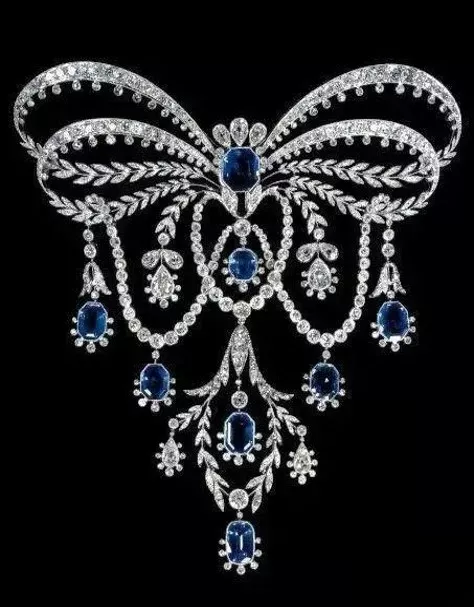
IV. Art Deco Era (1920s–1950s)
The Edwardian era was the last to be named after an emperor. When World War I broke out in 1914, it marked the abrupt end of the Edwardian glamour. This led us into the Art Deco period, which spanned from the 1920s to the 1950s.
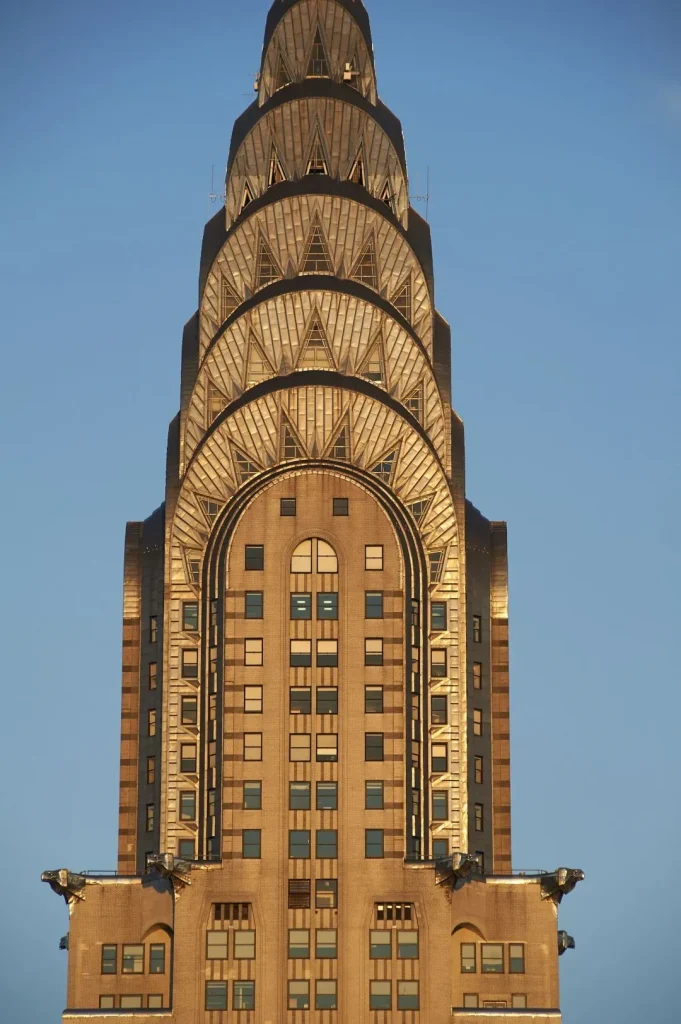
At the end of 1918, after the end of the Great War, the people were filled with joy, and their life motto was: rebirth and forget the past. They abandoned old traditions, beliefs, and fashion trends, ushering in a completely new scene. At this time, women were fully liberated. They stepped out of the home and, in order to better integrate into society, they discarded their corsets, cut their hair short, and wore skirts. The once-popular flower crown style and the fashion of the time had become completely outdated. What they needed now was a design combining simple geometry and lines. It was an era of opulence and indulgence, and the most discussed topic among everyone was: business.
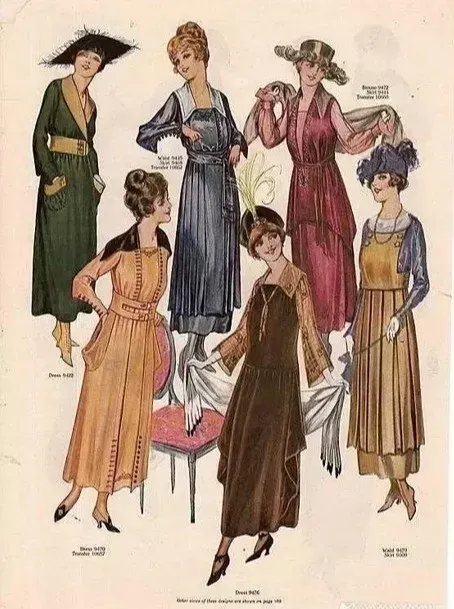
A Modern Look: Mechanical Geometric Designs in Art Deco Jewelry
In these typical Art Deco jewelry pieces, we can see that the jewelry of this era is characterized by mechanical, geometric, and purely decorative lines, such as fan-shaped sunrays, gears or streamlined lines, and symmetrical, minimalist geometric compositions. The double-band and double-clasp style also became an essential trend of the time.
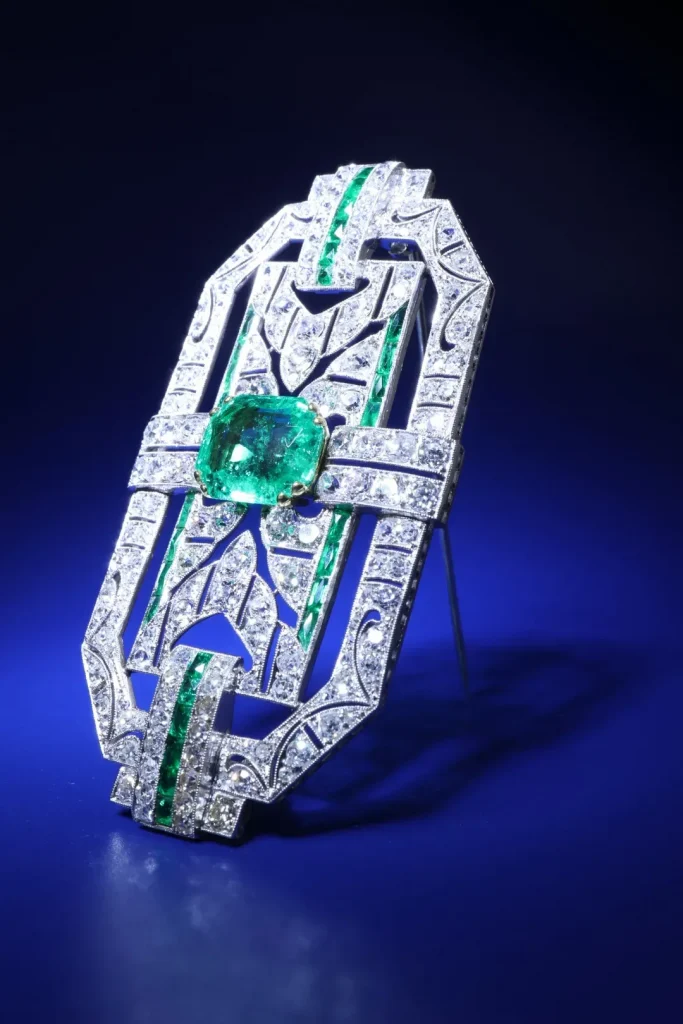
V. Retro Era (1950s–1960s)
The scarcity caused by the war lasted for several years, but by the late 1940s, jewelry fashion made a comeback. The final era we’ll discuss is the Retro period. Due to the rarity of precious gemstones, jewelry from this time tended to be larger, while diamonds and gemstones gradually became smaller.
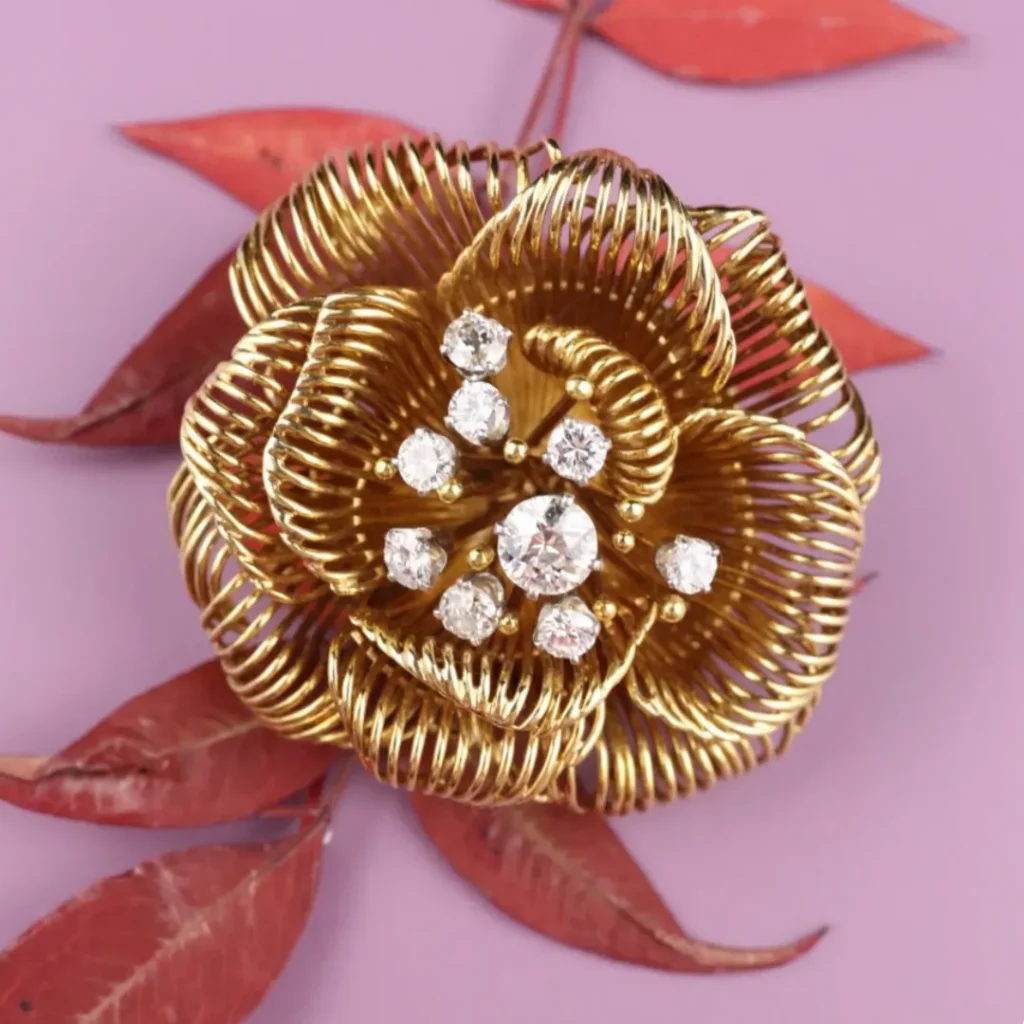
Popular designs during this period included scroll shapes, fan shapes, and rose motifs. In terms of metal materials, due to the rarity of platinum and the effects of the war, the era of white metals that lasted for 30 years came to an end, and gold made its return. The 1950s were a revival period for the jewelry industry, with various brands competing to release numerous innovative designs. Styles and designs flourished, with a diverse range of trends emerging from different brands.
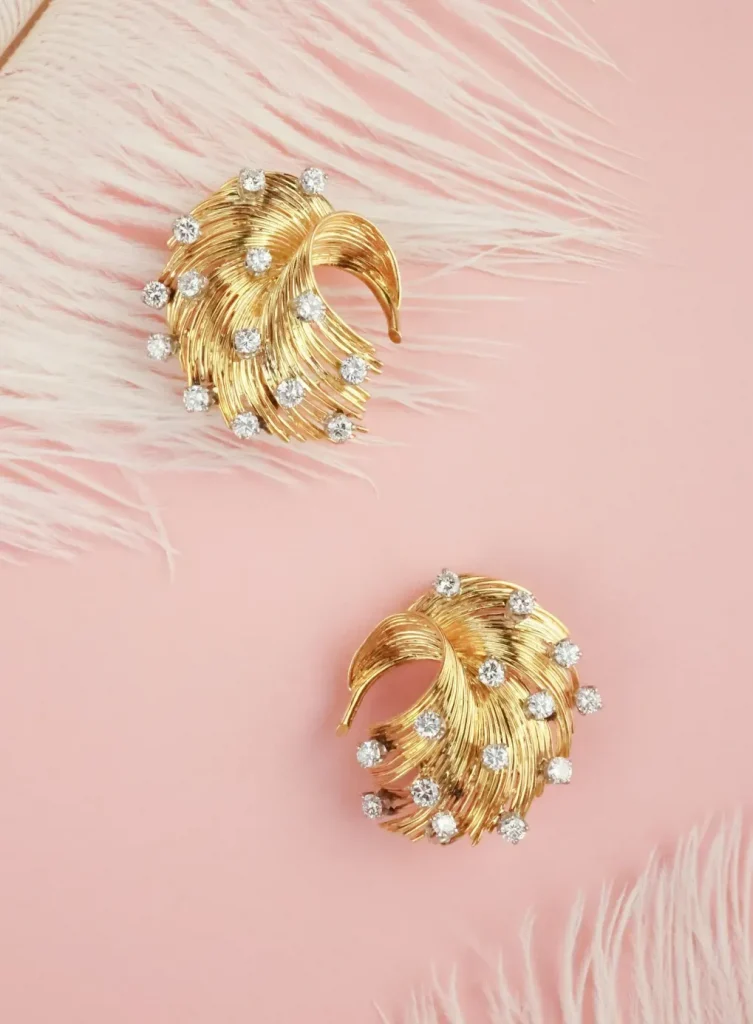
Post-War Glamour: The Bold Designs and Return of Gold in the Retro Period
From household pets to wild animals, from creatures that fly in the sky to those that crawl on the ground or swim in the sea, all have been incorporated into the design themes by the designers. Of course, floral and leaf motifs remain an essential and irreplaceable theme. In the world of gold and small gemstones, artisans competed in craftsmanship and design. During the Retro period, you’ll see many iconic creations from major brands. While they might not feature dazzling diamonds or precious gemstones, their designs and goldsmithing craftsmanship will still leave you in awe.
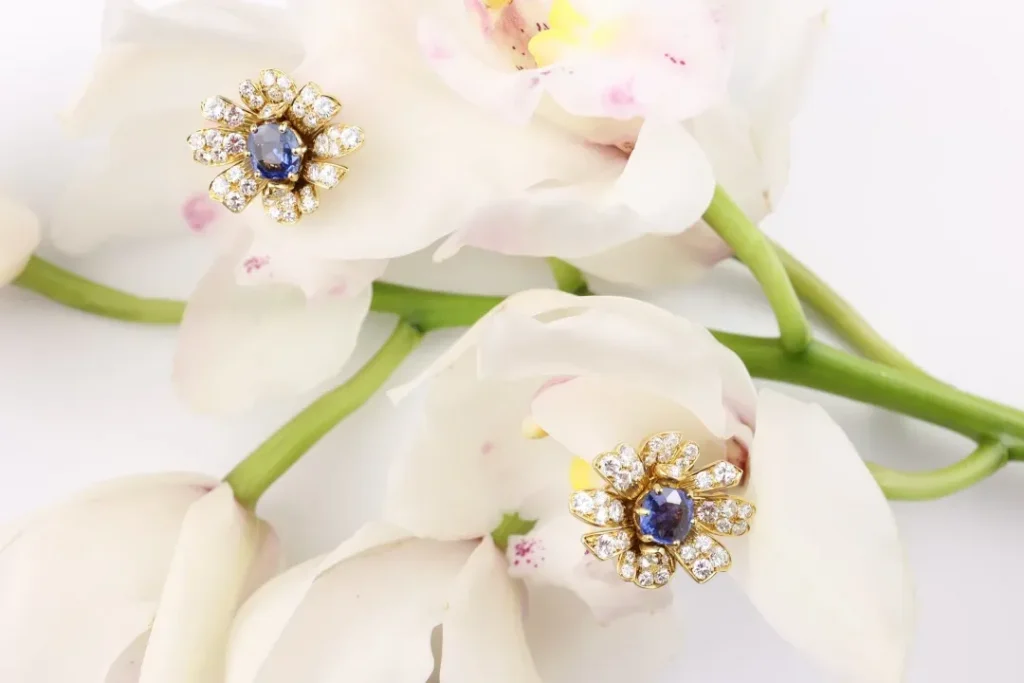
Today, I’ve provided a brief overview of the timeline of antique jewelry, aiming to connect the different eras as seamlessly as possible so that everyone can truly feel the shift of time. I hope you enjoyed it and we welcome you to join us for more of our upcoming knowledge sessions.

